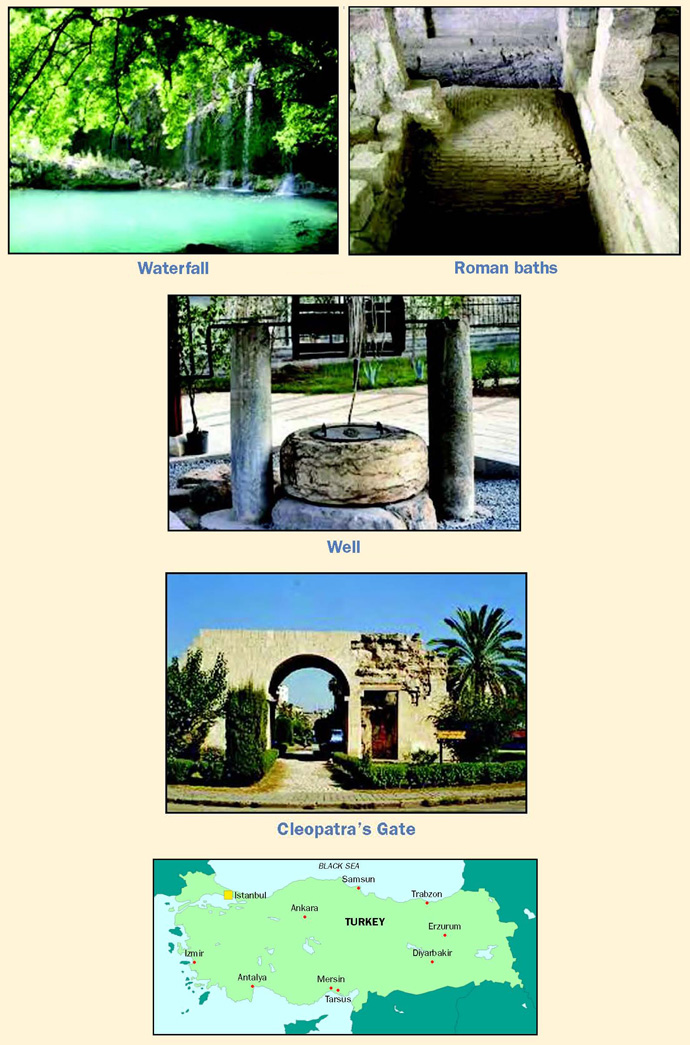
It may be argued that the city of Tarsus does not deserve to be included amongst the ranks of "Great Cities of the Bible". As its claim to fame is based solely on the fact that it was the birth-place of Saul of Tarsus this may give some credence to such a view. However, the birthplace of the Pharisee who persecuted the Church and later become Paul, the apostle to the Gentiles, is worthy of some consideration, as there he spent his early years.
The Location of the City
Tarsus is situated in south central Turkey, near to the western border of the Cilician plain. It still exists today and has a population of approximately 2.75 million. The site of the ancient city cannot be extensively excavated as the modern city occupies much of the location of the old. Although not situated on the shores of the Mediterranean it was only about 20 km distant, and the River Cydnus, which flowed through it, was navigable, allowing access to the Mediterranean ports. Inland there tower the Taurus Mountains which gave the city its river and a great part of its industry.
The Importance of the City
The great trade routes that led east and west passed through Tarsus. Its ideal situation can be seen from the map. The plain on which the city was situated, known as the "Cilician Gates", lay before the pass through the Taurus. These, together with the access to the Mediterranean, made Tarsus to be recognised as "no mean city" (Acts 21.39).
The goat flocks which were nurtured on the sides of the Taurus range provided in boundless quantity the goats’ hair which was used for weaving of ropes, tents, and garments. This was counted to be labour with the need of very little skill. In later years the young Saul would be taught this craft as it was customary for a Jewish child to learn such a trade. Another major industry was the use of the timber, again to be found in the Taurus forests. This commodity was floated downstream from Tarsus where it would be sent throughout the empire.
The History of the City
Very little that is reliable is known about Tarsus before approximately 400 BC. At that time the city was the seat of a Persian Governor (Satrap). Alexander the Great added this province to his territory during his campaign to take control of the Persian Empire. Indeed, he passed through the city in 333 BC, as he wrested Asia Minor from the grip of Persia. By this time the culture of the city was mainly Greek. Following the death of Alexander (323 BC) his empire was divided amongst his generals and Tarsus became part of the Seleucid Empire. This was to last until the Romans took control of the area. During that time the city was renowned as a centre of culture equalling that of Athens and Alexandria. At its peak it was reputed to have a library of 200,000 books. Even if this is regarded as an exaggeration it indicates the range of the books that were stored there.
It was Pompey, "the Great", doubtless one of the mightiest of Roman Generals, who was responsible for the annexation of Tarsus, placing it under Roman rule in 66 BC. It became the capital city of the Roman province of Cilicia. The Roman governor of the province resided there, and the city, therefore, received all the benefits that this status bestowed. Roman rule had been known in the area for some years before this, but it was Pompey who subdued opposition and formed the territory into one province. Public buildings and others of a grand nature would be constructed to display the dignity and authority of the city.
Julius Caesar reorganised this further in 47 BC and some twenty years later Cilicia became part of the province of Cilicia Syria. Although this may have reduced the importance of Tarsus it still was the "no mean city" to which reference has been made. Its importance to trade was undiminished and it still retained a degree of governmental authority.
It should not be forgotten, however, that it was in Tarsus during the civil wars that followed the assassination of Julius Caesar in Rome, which took place on the Ides of March, 44 BC, that Mark Anthony met Cleopatra, Queen of Egypt. This meeting proved ultimately disastrous for both of them, leading to their suicides in Egypt.
Roman Citizenship in the City
It is known that Julius Caesar, Mark Anthony, and Augustus conferred Roman citizenship on some of the citizens of Tarsus. This honour could be purchased, given to one who had rendered great service to the state, sometimes to retiring soldiers, perhaps at the whim of the conqueror, but conditions for bestowing it at times changed. The benefits of this honour were considerable:-
The right to vote in the in the era of the Republic.
The right to make legal contracts.
The right to have a lawful marriage.
The right to stand for public office.
The right to sue (and be sued) in the courts.
The right to appeal from the decisions of magistrates.
The right to have a trial (to appear before a proper court and to defend oneself).
Citizens could not be subjected to torture.
A Roman citizen could not be sentenced to death unless found guilty of treason.
If accused of treason, a Roman citizen had the right to be tried in Rome.
Even if sentenced to death, no Roman citizen could be sentenced to be crucified1
Saul of Tarsus
This, then, was the city where Saul lived as a boy. What can we learn of his early years? After the fall of Jerusalem to Babylon (606 BC), and long after that, a great number of Jews were driven from, or chose to leave, their homes. They became known as the diaspora, the scattered, and the Lord Jesus refers to them (Jn 11.52). The family of Saul must have at some time become part of "the scattered". Little is known of that family, not the name of his mother or of his father, nor the trade or profession in which his father engaged. We know only that he had a sister (Acts 23.16).
Jews of the Diaspora often adopted the dress, manners, and habits of their surrounding Gentile society, but others strove to maintain their Hebrew orthodoxy. The family of Saul was amongst the orthodox. Therefore, in writing to the Philippians he claimed that he had been "Circumcised the eight day, of the stock of Israel, of the tribe of Benjamin, an Hebrew of the Hebrews" (3.5). It was most likely, therefore, that from an early age he was tutored both in the tongue generally used, Greek, and in Hebrew. "No doubt his parents, proud of their Jewish origin, and living comparatively near to Palestine, would retain the power of conversing with their friends from thence in the ancient speech".2
The schooling available gave his parents three choices. They could educate him at home, at a Greek school, or at a Jewish school attached to a synagogue. It is almost certain that the third of these would have been the choice. Into the sharp, feverish mind of this child there was inculcated the Hebrew Scriptures and the history of the nation of which his parents were so proud.
His pious parents, however, determined that Saul’s education could only be completed at Jerusalem. What impressions must have gripped Saul as he left Tarsus behind and travelled, probably by road, through Antioch, on to Caesarea, and then to Jerusalem. There were two great rabbinical schools there: that of Schammai, and that of Hillel. The grandson of Hillel was the Pharisee, Gamaliel, and it was at his feet that the youthful Saul sat to be further instructed in the law (Acts 22.3). In this he made strong progress so that he had a profound knowledge of the Hebrew Scriptures, and along with that there was nurtured virulent opposition to the message of the followers of the One who claimed to be Messiah.
When Stephen was preaching the gospel so effectively in Jerusalem he faced strong resistance from the Jews who met in the synagogues of the Libertines and also in the synagogue of the Cyrenians, Alexandrians, and those of Cilicia.3 Note that the second of those is where Saul would have gathered: he was from Cilicia. Was it here that he debated with Stephen, the result of which was to add another "ox goad" (Acts 9.5) to trouble his conscience as he sought to silence the preachers of this message concerning the crucified Jesus of Nazareth? Still determined to continue this course, he held the coats of those who stoned Stephen, but one day, on the road to Damascus, he met the Risen Christ and the proud Pharisee became the bondservant of Jesus Christ.
1Extracts from Wikipedia
2Conybeare and Howson: The Life and Epistles of Paul.
3There are a number of views as to whether one, two, or five synagogues are noted in Acts 6.9. The view above is that of the Expositor’s Greek Testament.









